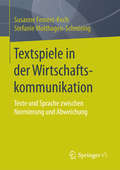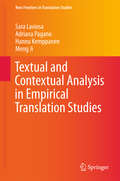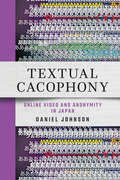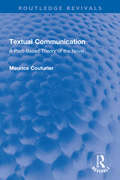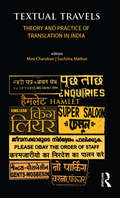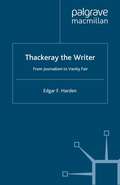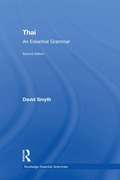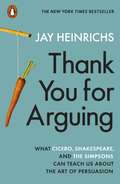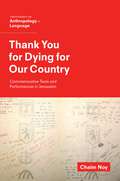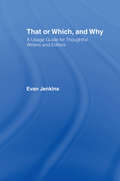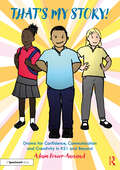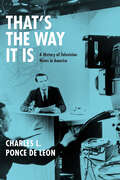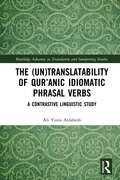- Table View
- List View
Textspiele in der Wirtschaftskommunikation: Texte und Sprache zwischen Normierung und Abweichung
by Susanne Femers-Koch Stefanie Molthagen-Schnöring Annette Uphaus-Wehmeier Christina Vaih-BaurDas Buch zeigt die Bandbreite zeitgenössischer Textprodukte in der Wirtschaftskommunikation auf, die durch verschiedene Varianten des Spiels mit Sprache und Text beeindrucken und eine lebendige Textkultur illustrieren können. Texte in Unternehmenskommunikation und Werbung folgen vielfach festgelegten Mustern. Pressemeldungen, Editorials oder Werbeanzeigen z.B. bieten als konventionelle Textsorten recht klare Orientierungen zu ihrem Inhalt und ihrer Form. Andere Texte wiederum sind vor allem deshalb aufmerksamkeitsstark und attraktiv, weil sie von Normen abweichen und spielerisch mit Erwartungen an Texte und ihren konventionellen Gestaltungsprinzipien umgehen. Zeitungsbeilagen in Form von Liebesbriefen, schillernde Unternehmensstorys, lyrische Verse in einer Werbeanzeige oder Wirtschaftspublikationen als Comic Strip z.B. informieren und unterhalten zugleich.
Textual and Contextual Analysis in Empirical Translation Studies (New Frontiers in Translation Studies)
by Sara Laviosa Adriana Pagano Hannu Kemppanen Meng JiThis book presents the state-of-art research in ETS by illustrating useful corpus methodologies in the study of important translational genres such as political texts, literature and media translations. Empirical Translation Studies (ETS) represents one of the most exciting fields of research. It gives emphasis and priority to the exploration and identification of new textual and linguistic patterns in large amounts of translation data gathered in the form of translation data bases. A distinct feature of current ETS is the testing and development of useful quantitative methods in the study of translational corpora. In this book, Hannu Kemppanen explores the distribution of ideologically loaded keywords in early Finnish translation of Russian political genres which yielded insights into the complex political relation between Finland and Russia in the post-Soviet era. Adriana Pagano uses multivariate analysis in the study of a large-scale corpus of Brazilian fiction translations produced between 1930s-1950s which is known as the golden age of Latin American translation. The statistical analysis detected a number of translation strategies in Brazilian Portuguese fictional translations which point to deliberate efforts made by translators to re-frame original English texts within the Brazilian social and political context in the first three decades under investigation. Meng Ji uses exploratory statistical techniques in the study of recent Chinese media translation by focusing three important media genres, i.e. reportage, editorial and review. The statistical analysis effectively detected important variations among three news genres which are analysed in light of the social and communicative functions of these news genres in informing and mobilising the audience in specific periods of time in Mainland China.
Textual Cacophony: Online Video and Anonymity in Japan
by Daniel JohnsonTextual Cacophony explores the behaviors and routines of communication within anonymous internet culture in Japan. Focusing on the video sharing website Niconico, social media aggregation sites, and the notorious 2channel message board, Daniel Johnson uncovers these sites' complex cultures of writing that obscure meaning through playful and opaque forms of deviant script and overwhelming waves of text. Those practices conflate language with images, meaning with play, and confound individual representation with aggregate forms of social identity. Johnson argues that online media cultures in and around Japan are entwined with a cultural logic and visual syntax of cacophony that expresses ambivalence toward representation, media form, and distinct experiences of time. This aesthetic of cacophony provides an alternative way of expressing social identity and belonging, with an unmarked sense of anonymity providing a counter-form to the dissolving institutions and relationships of neoliberal Japan. Textual Cacophony investigates what it means and feels like to participate in this influential online culture.
Textual Communication: A Print-Based Theory of the Novel (Routledge Revivals)
by Maurice CouturierFirst published in 1991, Textual Communication examines the character and development of the novel from Richardson to Nabokov in relation to the printing and publishing industry. The book blends literary theory with a historical analysis of communication, carrying the debate on the novel beyond the pioneering work of Booth and Genette, while responding to and taking issue with the writings of Foucault, Baudrillard, McLuhan, and Barthes. It analyses the structures of the industry which manufactured and marketed novels to show how novelists solved the communication problems that they faced in the eighteenth, nineteenth, and twentieth centuries. It also pinpoints critical moments in the history of the novel when new narrative strategies appeared, and places them in the context of the communication environment in which the texts were produced. Using Lacan’s theory of the divided subject, the book defines textual communication as a form of interaction in which two divided subjects, the author and the reader, try to communicate with each other under or against the law of the book market, censorship, literary conventions, and language.
Textual Communication: A Print-Based Theory of the Novel (Routledge Revivals)
by Maurice CouturierFirst published in 1991, Textual Communication examines the character and development of the novel from Richardson to Nabokov in relation to the printing and publishing industry. The book blends literary theory with a historical analysis of communication, carrying the debate on the novel beyond the pioneering work of Booth and Genette, while responding to and taking issue with the writings of Foucault, Baudrillard, McLuhan, and Barthes. It analyses the structures of the industry which manufactured and marketed novels to show how novelists solved the communication problems that they faced in the eighteenth, nineteenth, and twentieth centuries. It also pinpoints critical moments in the history of the novel when new narrative strategies appeared, and places them in the context of the communication environment in which the texts were produced. Using Lacan’s theory of the divided subject, the book defines textual communication as a form of interaction in which two divided subjects, the author and the reader, try to communicate with each other under or against the law of the book market, censorship, literary conventions, and language.
Textual Travels: Theory and Practice of Translation in India
by Mini Chandran Suchitra MathurThis book presents a comprehensive account of the theory and practice of translation in India in combining both its functional and literary aspects. It explores how the cultural politics of globalization is played out most powerfully in the realm of popular culture, and especially the role of translation in its practical facets, ranging from the fields of literature and publishing to media and sports.
Textual Travels: Theory and Practice of Translation in India
by Mini Chandran Suchitra MathurThis book presents a comprehensive account of the theory and practice of translation in India in combining both its functional and literary aspects. It explores how the cultural politics of globalization is played out most powerfully in the realm of popular culture, and especially the role of translation in its practical facets, ranging from the fields of literature and publishing to media and sports.
Thackeray the Writer: From Journalism to Vanity Fair
by E. HardenThis book conveys Thackeray's development as a book reviewer, journalist, art exhibition critic, short-story writer, satirical essayist and novelist a development that culminates in the creation of his masterpiece, Vanity Fair one of the glories of English imaginative writing. Articulating the connections between these vigorous and lively youthful works, and the growth of Thackeray as an increasingly profound participant observer, Harden reveals the exuberant imaginative growth and deepening understanding of a supremely perceptive critic of human social life.
Thai: An Essential Grammar (Routledge Essential Grammars)
by David SmythThis second edition of Thai: An Essential Grammar provides an up-to-date and concise reference guide to Thai grammar. Using clear, jargon-free explanations, it sets out the complexities of Thai in short, readable sections and presents an accessible description of the language. Focus is kept on the real patterns of use today and grammar forms are demonstrated through a wide range of relevant examples. No prior knowledge is assumed on the part of the reader. Features include: Coverage of crucial topics, such as sentence particles, negation, questions and quantification Examples given in both Thai script and romanised transliteration Pronunciation section Guidance on speech conventions and the Thai writing system Glossary of grammatical terms Two appendices covering Romanisation systems and three key verbs Bibliography This unique reference work will prove invaluable to all learners looking to master the grammar of Thai. It is ideal either for independent study or for students in schools, colleges, universities and adult classes of all types.
Thai: An Essential Grammar (Routledge Essential Grammars)
by David SmythThis second edition of Thai: An Essential Grammar provides an up-to-date and concise reference guide to Thai grammar. Using clear, jargon-free explanations, it sets out the complexities of Thai in short, readable sections and presents an accessible description of the language. Focus is kept on the real patterns of use today and grammar forms are demonstrated through a wide range of relevant examples. No prior knowledge is assumed on the part of the reader. Features include: Coverage of crucial topics, such as sentence particles, negation, questions and quantification Examples given in both Thai script and romanised transliteration Pronunciation section Guidance on speech conventions and the Thai writing system Glossary of grammatical terms Two appendices covering Romanisation systems and three key verbs Bibliography This unique reference work will prove invaluable to all learners looking to master the grammar of Thai. It is ideal either for independent study or for students in schools, colleges, universities and adult classes of all types.
Thank You for Arguing: What Cicero, Shakespeare and the Simpsons Can Teach Us About the Art of Persuasion
by Jay HeinrichsTHE NEW YORK TIMES BESTSELLERYour ultimate guide to the art of winning arguments, in a brand new editionEveryone is always trying to persuade us of something: politicians, advertising, the media, and most definitely our families. Thank You for Arguing is your master class in the art of persuasion, taught by professors ranging from Bart Simpson to Winston Churchill. With all the wisdom of the ages, from classical oratory to contemporary politics and pop-culture, Thank You For Arguing shows you how to win more than your fair share of arguments, as well as: >How to shine at work, avoid speeding tickets, and outwit argumentative partners >Cicero's secrets to moving an audience, Donald Trump's savvy speechmaking, the art of giving a TED talk>Tactics like Setting Your Goals, Making Them Like You, Gaining the High Ground>Defuse an angry accuser and benefit from your own mistakes>The art of rhetoric, from eloquence and friendship to wit and irrefutable logicWritten by one of today's most popular online language experts, Thank You For Arguing is brimming with time-tested rhetorical tips and persuasion techniques that will change your life. And that's not hyperbole.
THANK YOU FOR DYING FOR COUNTRY OSANTL C: Commemorative Texts and Performances in Jerusalem (Oxf Studies in Anthropology of Language)
by Chaim NoyCombining ethnographic, semiotic, and performative approaches, this book examines texts and accompanying acts of writing of national commemoration. The commemorative visitor book is viewed as a mobilized stage, a communication medium, where visitors' public performances are presented, and where acts of participation are authored and composed. The study contextualizes the visitor book within the material and ideological environment where it is positioned and where it functions. The semiotics of commemoration are mirrored in the visitor book, which functions as a participatory platform that becomes an extension of the commemorative spaces in the museum. The study addresses tourists' and visitors' texts, i.e. the commemorative entries in the book, which are succinct dialogical utterances. Through these public performances, individuals and groups of visitors align and affiliate with a larger imagined national community. Reading the entries allows a unique perspective on communication practices and processes, and vividly illustrates such concepts as genre, voice, addressivity, indexicality, and the very acts of writing and reading. The book's many entries tell stories of affirming, but also resisting the narrative tenets of Zionist national identity, and they illustrate the politics of gender and ethnicity in Israel society. The book presents many ethnographic observations and interviews, which were done both with the management of the site (Ammunition Hill National Memorial Site), and with the visitors themselves. The observations shed light on processes and practices involved in writing and reading, and on how visitors decide on what to write and how they collaborate on drafting their entries. The interviews with the site's management also illuminate the commemoration projects, and how museums and exhibitions are staged and managed.
Thank You for Dying for Our Country: Commemorative Texts and Performances in Jerusalem (Oxf Studies in Anthropology of Language)
by Chaim NoyCombining ethnographic, semiotic, and performative approaches, this book examines texts and accompanying acts of writing of national commemoration. The commemorative visitor book is viewed as a mobilized stage, a communication medium, where visitors' public performances are presented, and where acts of participation are authored and composed. The study contextualizes the visitor book within the material and ideological environment where it is positioned and where it functions. The semiotics of commemoration are mirrored in the visitor book, which functions as a participatory platform that becomes an extension of the commemorative spaces in the museum. The study addresses tourists' and visitors' texts, i.e. the commemorative entries in the book, which are succinct dialogical utterances. Through these public performances, individuals and groups of visitors align and affiliate with a larger imagined national community. Reading the entries allows a unique perspective on communication practices and processes, and vividly illustrates such concepts as genre, voice, addressivity, indexicality, and the very acts of writing and reading. The book's many entries tell stories of affirming, but also resisting the narrative tenets of Zionist national identity, and they illustrate the politics of gender and ethnicity in Israel society. The book presents many ethnographic observations and interviews, which were done both with the management of the site (Ammunition Hill National Memorial Site), and with the visitors themselves. The observations shed light on processes and practices involved in writing and reading, and on how visitors decide on what to write and how they collaborate on drafting their entries. The interviews with the site's management also illuminate the commemoration projects, and how museums and exhibitions are staged and managed.
That or Which, and Why: A Usage Guide for Thoughtful Writers and Editors
by Evan JenkinsThat or Which, and Why is an insightful and witty guide to writing. Based on Evan Jenkins's long-running column 'Language Corner' in Columbia Journalism Review, the book is compiled of brief, alphabetically arranged entries on approximately 200 major writing stumbling blocks, from the wonderful world of 'that' and 'which' to trickier terrain like the correct usage of common idiomatic expressions.Working from his experiences as a newsroom editor and teacher, Jenkins' humorous tone puts the reader at ease, unlike many of the writing and usage guides out there that are off-putting in their rigidity and dogmatism. He takes the 'we're-all-in-this-together' approach to teaching better writing - maintaining a light tone throughout the book and emphasizing flexibility and easy-to-use guidelines rather than delivering orders from Grammar-on-high.
That or Which, and Why: A Usage Guide for Thoughtful Writers and Editors
by Evan JenkinsThat or Which, and Why is an insightful and witty guide to writing. Based on Evan Jenkins's long-running column 'Language Corner' in Columbia Journalism Review, the book is compiled of brief, alphabetically arranged entries on approximately 200 major writing stumbling blocks, from the wonderful world of 'that' and 'which' to trickier terrain like the correct usage of common idiomatic expressions.Working from his experiences as a newsroom editor and teacher, Jenkins' humorous tone puts the reader at ease, unlike many of the writing and usage guides out there that are off-putting in their rigidity and dogmatism. He takes the 'we're-all-in-this-together' approach to teaching better writing - maintaining a light tone throughout the book and emphasizing flexibility and easy-to-use guidelines rather than delivering orders from Grammar-on-high.
That's My Story!: Drama for Confidence, Communication and Creativity in KS1 and Beyond
by Adam Power-AnnandThe ability to communicate is an essential life skill for all children and young people and it underpins their social, emotional and educational development. If a child experiences a positive relationship with an adult listening carefully, they are more likely to constructively share their thoughts, feelings and their imaginative ideas.That’s My Story! places children’s imagined stories at the heart of their own development and provides a joyful, creative approach to support young children’s personal and social development and to encourage their communication. In this book you will find: Tried-and-tested drama games and activities that support communication and well-being, all adaptable to complement your current practice Guidance and advice on how to promote positive adult-child interactions Examples of creative interventions that support children’s communication development A celebration of the joy that comes with carefully listening to children’s own imagined stories Those of us who work with children can sense a tangible connection between how young children feel and how they communicate. This essential and practical resource will be valuable reading for primary teachers, teaching assistants, speech and language therapists, and drama practitioners, as well as outreach and education departments of theatre companies and other arts organisations.
That's My Story!: Drama for Confidence, Communication and Creativity in KS1 and Beyond
by Adam Power-AnnandThe ability to communicate is an essential life skill for all children and young people and it underpins their social, emotional and educational development. If a child experiences a positive relationship with an adult listening carefully, they are more likely to constructively share their thoughts, feelings and their imaginative ideas.That’s My Story! places children’s imagined stories at the heart of their own development and provides a joyful, creative approach to support young children’s personal and social development and to encourage their communication. In this book you will find: Tried-and-tested drama games and activities that support communication and well-being, all adaptable to complement your current practice Guidance and advice on how to promote positive adult-child interactions Examples of creative interventions that support children’s communication development A celebration of the joy that comes with carefully listening to children’s own imagined stories Those of us who work with children can sense a tangible connection between how young children feel and how they communicate. This essential and practical resource will be valuable reading for primary teachers, teaching assistants, speech and language therapists, and drama practitioners, as well as outreach and education departments of theatre companies and other arts organisations.
That's the Way It Is: A History of Television News in America
by Charles L. Ponce de LeonWhen critics decry the current state of our public discourse, one reliably easy target is television news. It’s too dumbed-down, they say; it’s no longer news but entertainment, celebrity-obsessed and vapid. The critics may be right. But, as Charles L. Ponce de Leon explains in That’s the Way It Is, TV news has always walked a fine line between hard news and fluff. The familiar story of decline fails to acknowledge real changes in the media and Americans’ news-consuming habits, while also harking back to a golden age that, on closer examination, is revealed to be not so golden after all. Ponce de Leon traces the entire history of televised news, from the household names of the late 1940s and early ’50s, like Eric Sevareid, Edward R. Murrow, and Walter Cronkite, through the rise of cable, the political power of Fox News, and the satirical punch of Colbert and Stewart. He shows us an industry forever in transition, where newsmagazines and celebrity profiles vie with political news and serious investigations. The need for ratings success—and the lighter, human interest stories that can help bring it—Ponce de Leon makes clear, has always sat uneasily alongside a real desire to report hard news. Highlighting the contradictions and paradoxes at the heart of TV news, and telling a story rich in familiar figures and fascinating anecdotes, That’s the Way It Is will be the definitive account of how television has showed us our history as it happens.
That's the Way It Is: A History of Television News in America
by Charles L. Ponce de LeonWhen critics decry the current state of our public discourse, one reliably easy target is television news. It’s too dumbed-down, they say; it’s no longer news but entertainment, celebrity-obsessed and vapid. The critics may be right. But, as Charles L. Ponce de Leon explains in That’s the Way It Is, TV news has always walked a fine line between hard news and fluff. The familiar story of decline fails to acknowledge real changes in the media and Americans’ news-consuming habits, while also harking back to a golden age that, on closer examination, is revealed to be not so golden after all. Ponce de Leon traces the entire history of televised news, from the household names of the late 1940s and early ’50s, like Eric Sevareid, Edward R. Murrow, and Walter Cronkite, through the rise of cable, the political power of Fox News, and the satirical punch of Colbert and Stewart. He shows us an industry forever in transition, where newsmagazines and celebrity profiles vie with political news and serious investigations. The need for ratings success—and the lighter, human interest stories that can help bring it—Ponce de Leon makes clear, has always sat uneasily alongside a real desire to report hard news. Highlighting the contradictions and paradoxes at the heart of TV news, and telling a story rich in familiar figures and fascinating anecdotes, That’s the Way It Is will be the definitive account of how television has showed us our history as it happens.
That's the Way It Is: A History of Television News in America
by Charles L. Ponce de LeonWhen critics decry the current state of our public discourse, one reliably easy target is television news. It’s too dumbed-down, they say; it’s no longer news but entertainment, celebrity-obsessed and vapid. The critics may be right. But, as Charles L. Ponce de Leon explains in That’s the Way It Is, TV news has always walked a fine line between hard news and fluff. The familiar story of decline fails to acknowledge real changes in the media and Americans’ news-consuming habits, while also harking back to a golden age that, on closer examination, is revealed to be not so golden after all. Ponce de Leon traces the entire history of televised news, from the household names of the late 1940s and early ’50s, like Eric Sevareid, Edward R. Murrow, and Walter Cronkite, through the rise of cable, the political power of Fox News, and the satirical punch of Colbert and Stewart. He shows us an industry forever in transition, where newsmagazines and celebrity profiles vie with political news and serious investigations. The need for ratings success—and the lighter, human interest stories that can help bring it—Ponce de Leon makes clear, has always sat uneasily alongside a real desire to report hard news. Highlighting the contradictions and paradoxes at the heart of TV news, and telling a story rich in familiar figures and fascinating anecdotes, That’s the Way It Is will be the definitive account of how television has showed us our history as it happens.
That's the Way It Is: A History of Television News in America
by Charles L. Ponce de LeonWhen critics decry the current state of our public discourse, one reliably easy target is television news. It’s too dumbed-down, they say; it’s no longer news but entertainment, celebrity-obsessed and vapid. The critics may be right. But, as Charles L. Ponce de Leon explains in That’s the Way It Is, TV news has always walked a fine line between hard news and fluff. The familiar story of decline fails to acknowledge real changes in the media and Americans’ news-consuming habits, while also harking back to a golden age that, on closer examination, is revealed to be not so golden after all. Ponce de Leon traces the entire history of televised news, from the household names of the late 1940s and early ’50s, like Eric Sevareid, Edward R. Murrow, and Walter Cronkite, through the rise of cable, the political power of Fox News, and the satirical punch of Colbert and Stewart. He shows us an industry forever in transition, where newsmagazines and celebrity profiles vie with political news and serious investigations. The need for ratings success—and the lighter, human interest stories that can help bring it—Ponce de Leon makes clear, has always sat uneasily alongside a real desire to report hard news. Highlighting the contradictions and paradoxes at the heart of TV news, and telling a story rich in familiar figures and fascinating anecdotes, That’s the Way It Is will be the definitive account of how television has showed us our history as it happens.
That's the Way It Is: A History of Television News in America
by Charles L. Ponce de LeonWhen critics decry the current state of our public discourse, one reliably easy target is television news. It’s too dumbed-down, they say; it’s no longer news but entertainment, celebrity-obsessed and vapid. The critics may be right. But, as Charles L. Ponce de Leon explains in That’s the Way It Is, TV news has always walked a fine line between hard news and fluff. The familiar story of decline fails to acknowledge real changes in the media and Americans’ news-consuming habits, while also harking back to a golden age that, on closer examination, is revealed to be not so golden after all. Ponce de Leon traces the entire history of televised news, from the household names of the late 1940s and early ’50s, like Eric Sevareid, Edward R. Murrow, and Walter Cronkite, through the rise of cable, the political power of Fox News, and the satirical punch of Colbert and Stewart. He shows us an industry forever in transition, where newsmagazines and celebrity profiles vie with political news and serious investigations. The need for ratings success—and the lighter, human interest stories that can help bring it—Ponce de Leon makes clear, has always sat uneasily alongside a real desire to report hard news. Highlighting the contradictions and paradoxes at the heart of TV news, and telling a story rich in familiar figures and fascinating anecdotes, That’s the Way It Is will be the definitive account of how television has showed us our history as it happens.
That's the Way It Is: A History of Television News in America
by Charles L. Ponce de LeonWhen critics decry the current state of our public discourse, one reliably easy target is television news. It’s too dumbed-down, they say; it’s no longer news but entertainment, celebrity-obsessed and vapid. The critics may be right. But, as Charles L. Ponce de Leon explains in That’s the Way It Is, TV news has always walked a fine line between hard news and fluff. The familiar story of decline fails to acknowledge real changes in the media and Americans’ news-consuming habits, while also harking back to a golden age that, on closer examination, is revealed to be not so golden after all. Ponce de Leon traces the entire history of televised news, from the household names of the late 1940s and early ’50s, like Eric Sevareid, Edward R. Murrow, and Walter Cronkite, through the rise of cable, the political power of Fox News, and the satirical punch of Colbert and Stewart. He shows us an industry forever in transition, where newsmagazines and celebrity profiles vie with political news and serious investigations. The need for ratings success—and the lighter, human interest stories that can help bring it—Ponce de Leon makes clear, has always sat uneasily alongside a real desire to report hard news. Highlighting the contradictions and paradoxes at the heart of TV news, and telling a story rich in familiar figures and fascinating anecdotes, That’s the Way It Is will be the definitive account of how television has showed us our history as it happens.
The: A Contrastive Linguistic Study (Routledge Advances in Translation and Interpreting Studies)
by Ali Yunis AldaheshQur’anic idiomaticity, in its all aspects, poses a great deal of challenge to Qur’an readers, learners, commentators, and translators. One of the most challenging aspects of Qur’anic idiomaticity is Qur’anic idiomatic phrasal verbs, where significances of proper Arabic verbs are entirely fused with significances of prepositions following them to produce new significances that have nothing to do with the basic significances of those verbs and prepositions. By examining a corpus of ten of the most influential English translations of the Qur’an, this study scrutinizes how some translators of the Qur’an have dealt with the phenomenon of Qur’anic idiomatic phrasal verbs, the difficulties that they have encountered when translating them into English, and the strategies that they have employed in their attempts to overcome the inherent ambiguity of such expressions and provide their functional-pragmatic equivalents for English readership. The study proposes a working model for analysing and assessing the translation of the Qur’anic idiomatic phrasal verbs and provides a number of theory-based recommendations for translators in general and Qur’an translators in particular.
The: A Contrastive Linguistic Study (Routledge Advances in Translation and Interpreting Studies)
by Ali Yunis AldaheshQur’anic idiomaticity, in its all aspects, poses a great deal of challenge to Qur’an readers, learners, commentators, and translators. One of the most challenging aspects of Qur’anic idiomaticity is Qur’anic idiomatic phrasal verbs, where significances of proper Arabic verbs are entirely fused with significances of prepositions following them to produce new significances that have nothing to do with the basic significances of those verbs and prepositions. By examining a corpus of ten of the most influential English translations of the Qur’an, this study scrutinizes how some translators of the Qur’an have dealt with the phenomenon of Qur’anic idiomatic phrasal verbs, the difficulties that they have encountered when translating them into English, and the strategies that they have employed in their attempts to overcome the inherent ambiguity of such expressions and provide their functional-pragmatic equivalents for English readership. The study proposes a working model for analysing and assessing the translation of the Qur’anic idiomatic phrasal verbs and provides a number of theory-based recommendations for translators in general and Qur’an translators in particular.
